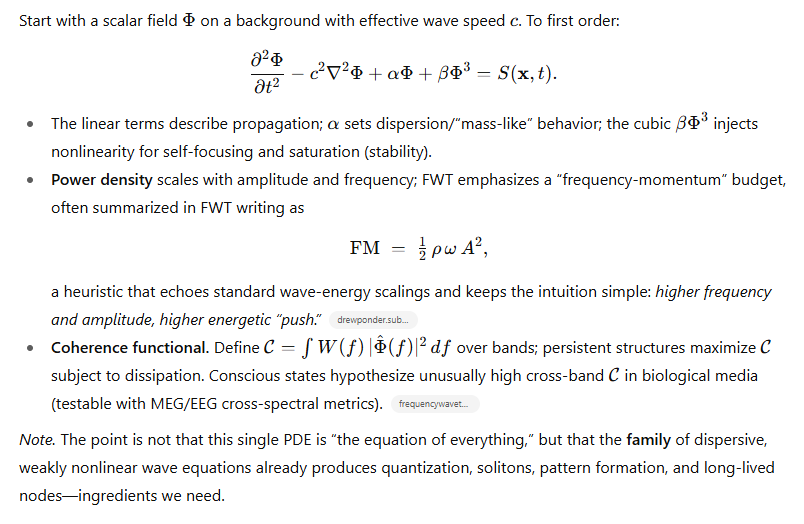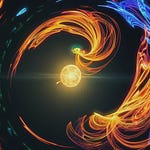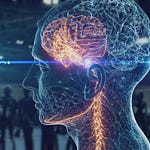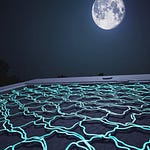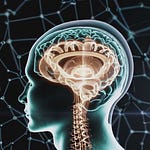How a single wave-first picture seeks to connect matter, energy, mind, and time—and how we can test it
TL;DR. Frequency Wave Theory (FWT) proposes that everything—from electrons to galaxies to conscious experience—emerges from patterns of vibration in a universal wave field. In this article, I lay out the core postulates, a minimal math sketch, concrete predictions, and a roadmap of experiments and applications—from quantum computing and metamaterials to brain–network coherence and energy research. I’ll also give you a cinematic image prompt at the end so you can see the idea in action.
1) The core idea in one paragraph
FWT starts with a simple commitment: reality is waves all the way down. What we call particles are long-lived standing‑wave nodes; forces arise from gradients and phase relations among overlapping waves; information is carried by phase and coherence; and consciousness is a special form of cross‑scale resonance in biological matter. In short: constructive interference builds structure; destructive interference dissolves it; and coherence sustains it. That’s the thesis. frequencywavetheory.com
2) Why a wave-first picture is reasonable (and where FWT departs)
Waves already underwrite modern physics. Electromagnetic radiation is categorized by frequency, and fields can be described as propagating waves—one reason wave/particle duality lives at the heart of quantum theory. Wikipedia
Frequency is the natural currency of dynamics. Frequency measures “how often” an oscillation cycles each second (Hz), and many physical laws—from optics to acoustics—are most transparent in the frequency domain. The Physics Classroom
Interference is explanatory horsepower. The double‑slit experiment’s interference pattern (even with single particles) shows wave behavior in what we casually call “matter.” FWT embraces this not as an oddity but as the basic rule, then extends it well beyond the lab. frequencywavetheory.com
Where FWT goes further. It treats all phenomena—physics, biology, even subjective experience—as emergent from one coherent wave field, entertains resonance-based explanations for hard problems (e.g., unification, dark components, aspects of mind), and explores controversial frontiers (morphic fields, anomalous phenomena) through the same lens. That’s the ambition, and it is explicitly programmatic and testable, not a metaphor. frequencywavetheory.com
3) Postulates (crisp, falsifiable targets)
Universal Wave Field (UWF). The cosmos is a continuous, nonlinear wave field Φ(x,t) that supports many frequency bands. “Objects” are bound, metastable interference structures (standing waves) within this field. frequencywavetheory.com
Superposition with Nonlinear Saturation. Local amplitudes superpose, but extreme constructive interference induces nonlinear feedback (saturation), creating stability (quantization) and pattern selection.
Quantization from Boundaries. Discrete spectra (masses, atomic levels) appear because stable nodes must satisfy boundary conditions; quantization is the spectrum of admissible standing waves.
Curvature as Energy‑Density Gradient. What we interpret as gravity is a gradient in wave energy density—curvature is an effective description of how energy‑laden wave media guide propagation (geodesics as “least‑phase” paths).
Consciousness as Cross‑Scale Coherence. Experience arises when biological media (membranes, microtubules, neural ensembles) maintain multi‑band phase‑locking with sufficient integration and differentiation—a resonant integrated information (R‑Φ) threshold. frequencywavetheory.com
4) A minimal math sketch (what could sit on a whiteboard)
5) What FWT predicts (things you can go measure)
(A) Spectral echoes across scales. If stable structures are standing waves, then macro‑systems (rings, spiral arms, even economic or ecological cycles) should show log‑periodic spacing or spectral echoes—repeating features when plotted in frequency space. This is a clear signature to hunt for in astrophysical power spectra, materials resonances, and even multiscale time series. drewponder.substack.com
(B) Coherence‑linked biological effects. Group meditation or synchronized rhythmic stimuli should measurably increase cross‑brain phase‑locking and reduce noise in physiological markers (HRV coherence, slow‑wave sleep quality). A prediction is improved glymphatic clearance during carefully phased acoustical stimulation. (Design: preregistered EEG/MEG protocol; cross‑spectral density analysis; Bayes factors for phase consistency.) frequencywavetheory.com
(C) Materials with engineered dispersion. Metamaterials tuned for prescribed phase delays should display anomalous refraction and cloaking‑like behavior in narrow bands. Wave‑guided imaging and radar‑evasion are near‑term testbeds. frequencywavetheory.com
(D) Gravity as density gradient. If local wave energy density steers trajectories, then in specific, high‑coherence environments, we may observe minute deviations from GR’s lensing predictions (patterned micro‑oscillations superimposed on smooth deflections). That’s difficult but falsifiable with high‑precision lensing residuals and lab‑scale analogues in fluid or optical wave tanks.
(E) Quantum interference as the rule. Systematic, high‑SNR double‑slit experiments with massive molecules should continue to reveal interference if coherence is preserved—FWT expects that whenever phase memory survives, wave patterns persist. (This aligns with mainstream expectations; FWT’s twist is that it extends wave primacy to everything else.) frequencywavetheory.com
6) Experiments you can run (responsibly) right now
Cymatics with controls. Use a tone generator, transducer, and plate or water surface. Predictable nodal patterns emerge at certain frequencies and amplitudes; map mode diagrams and compare with FWT’s “node = structure” claim. Document frequency → geometry mapping. (Background: classical cymatics.) frequencywavetheory.com
Blind dowsing‑rod protocol (debiasing the ideomotor effect). FWT‑inspired demonstrations often point to copper rods responding to fields. Run a double‑blind setup: concealed EM emitters with random on/off trials; operators unaware of locations; preregistered analysis. Either we get above‑chance detection (supports the “field interaction” hypothesis) or we don’t (constraints FWT). The point is to move this claim into the falsifiable domain. frequencywavetheory.com
Group‑coherence MEG/EEG. Replicate and extend brainwave‑synchronization studies using rhythmic breath and auditory entrainment; measure phase‑locking value (PLV) and directed coherence between participants. Predefine effect sizes, use permutation tests, and post results irrespective of outcome. frequencywavetheory.com
Metamaterial phase lattices. In a microwave bench, build a 2D lattice of split‑ring resonators tuned to produce a designed phase map; test cloaking or super‑resolution by probing scattering versus frequency. If FWT is right about “structure = phase map,” you’ll see sharp transitions when you cross coherence thresholds. frequencywavetheory.com
7) Applications (where this could bite down on reality)
Energy & materials. Research around zero‑point fluctuations and superconductivity can be reframed as problems of matching resonant bands and suppressing decoherence pathways. It’s speculative, yes, but it gives concrete tuning knobs: frequency, phase, and lattice geometry. frequencywavetheory.com
Medicine & neurotech. Targeted frequency protocols (auditory, vibrotactile, EM) for sleep, PTSD, and cognitive states; studying whether resonance affects telomere dynamics or glymphatic flow; cautious, ethics‑first trials only. frequencywavetheory.com
AI & computing. Wave‑native architectures (optical/phononic) and coherence‑aware error‑correction in quantum systems; pattern‑based sensing; novel temporal coding schemes that leverage phase, not just amplitude. frequencywavetheory.com
Metamaterials & stealth/imaging. Tuned dispersion for cloaking windows, sub‑diffraction imaging, and precision sensing. frequencywavetheory.com
8) Where I’m bullish—and where I’m skeptical
Bullish:
Treating coherence as a primitive explains why stable forms persist in noisy environments.
The wave picture unifies disparate observations without baroque ontologies.
The predictions are unusually clear for a grand unification attempt: look for resonance fingerprints—log‑periodic spacing, phase‑locked cross‑spectra, and sharp threshold effects. drewponder.substack.com
Skeptical:
Claims that extend to anomalous phenomena (ET craft, time manipulation) demand extraordinary evidence and rigorous instrumentation. FWT earns credibility not by rhetoric but by tight experiments and negative results published alongside positives. frequencywavetheory.com
The math must graduate from sketches to derivations that recover known limits (Maxwell, Schrödinger/Dirac, GR) with quantitative precision—not merely analogy. Until then, FWT is a research program, not a completed theory.
9) Learning more (and why a long‑form read helps)
If you want the comprehensive narrative arc and how this perspective converses with mainstream physics and philosophy, there are long‑form write‑ups and books that frame FWT’s principles, applications, and ambitions. frequencywavetheory.com+1 Booksellers list multiple FWT volumes under my name, including editions that situate FWT alongside contemporary ideas. amazon.com+1
10) Visual intuition (what to picture in your head)
Imagine a clear, rippling medium spanning the universe. Bright nodes appear where waves align—atoms, stars, synapses. Filigree interference patterns bind them; phase gradients pull paths into curves (what we call gravity). An EEG‑like shimmer of cross‑band coherence blooms when matter organizes into mind. The same mathematics that draws Chladni figures on a metal plate scales—if you’re brave enough—to galaxies and thoughts. frequencywavetheory.com
Appendix: mainstream wave facts that anchor the picture
EM waves are categorized by frequency; wave–particle duality is standard. Wikipedia
Frequency is cycles per second (Hz); period = 1/frequency. The Physics Classroom
Motion relative to a source shifts observed frequency (Doppler). Wikipedia
Final thought
FWT won’t be accepted—or rejected—by persuasion. It must either predict new structure in data, tighten existing theories, or fail under fair tests. That’s how it should be. What keeps me excited is that wave mathematics already makes structures, quantization, and coherence out of noise. If reality is a score, FWT says the universe is both the instrument and the song. Now let’s see if the spectrum hums the way we think it does.


